In the world of botanical wonders, succulents stand out for their resilience, unique forms, and captivating beauty. Among these, hanging succulents take center stage, weaving a tale of elegance suspended in the air. As we embark on a journey through the lush tapestry of trailing foliage, we discover a world where nature’s artistry meets dynamic design.
Hanging succulents, with their cascading tendrils and jewel-toned leaves, are more than just plants; they are living sculptures, transforming any space into a green sanctuary. This article is a celebration of ten such hanging succulents, each a masterpiece in its own right. From the delicate pearls of the String of Pearls to the exotic allure of the String of Hearts, these succulents redefine traditional gardening, bringing greenery to new heights—literally.
Join us as we explore the care tips and unique characteristics of these ten hanging succulents, discovering why they’ve become the darlings of the botanical world. Let’s unravel the secrets behind their cascading grace and learn how these suspended wonders can turn any space into a haven of natural sophistication.
Table of Contents
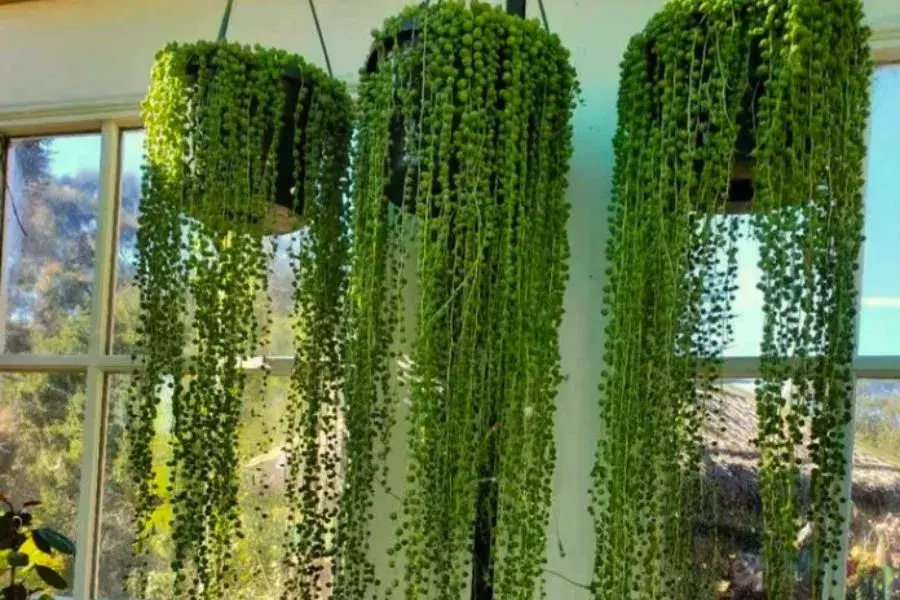
Why Hanging Succulents?
When it comes to succulents, many plant enthusiasts are captivated by the unique charm of hanging succulents. These botanical wonders not only bring a touch of the exotic into your living space but also provide a dynamic and versatile way to showcase nature’s beauty. Let’s explore the distinctive qualities that make hanging succulents a must-have for any plant lover:
Space-Saving Elegance
Hanging succulents, such as String of Pearls and String of Fishhooks, effortlessly elevate your greenery to new heights, literally. Ideal for those with limited space, these trailing beauties drape elegantly, turning any corner into a lush oasis without taking up valuable floor space.
Living Art Installations
Transform your living space into a canvas of living art with the cascading beauty of hanging succulents. Whether adorning a macramé hanger or suspended in glass terrariums, these plants create captivating installations that evolve as they gracefully grow and trail.
Dynamic Design Options
Hanging succulents offer dynamic design possibilities. Mix and match different varieties to create a vibrant tapestry of textures and colors. Their versatility extends to various containers, from classic pots to creative hanging baskets, allowing you to personalize your green haven.
Natural Air Purifiers
Beyond their aesthetic appeal, hanging succulents contribute to a healthier indoor environment. Like their counterparts, these plants are natural air purifiers, removing toxins and impurities while releasing fresh oxygen. Their ability to thrive indoors makes them excellent companions for enhancing air quality.
Stress-Free Maintenance
For those seeking low-maintenance green companions, hanging succulents fit the bill. Their water-storing leaves and adaptability to various light conditions make them resilient and forgiving, perfect for both novice and experienced plant enthusiasts.
A Solution for Pet-Friendly Spaces
With many traditional houseplants being toxic to pets, hanging succulents offer a pet-friendly alternative. Suspended out of reach, they provide a solution for plant lovers with furry friends, allowing for a harmonious coexistence of greenery and pets in the same space.
Learn about 12 Stunning Types of Purple Succulents
10 Most Popular Hanging Succulents
Here is a list of the top 10 hanging succulent plants for your sanctuary:
1. String of Pearls (Curio rowleyanus)
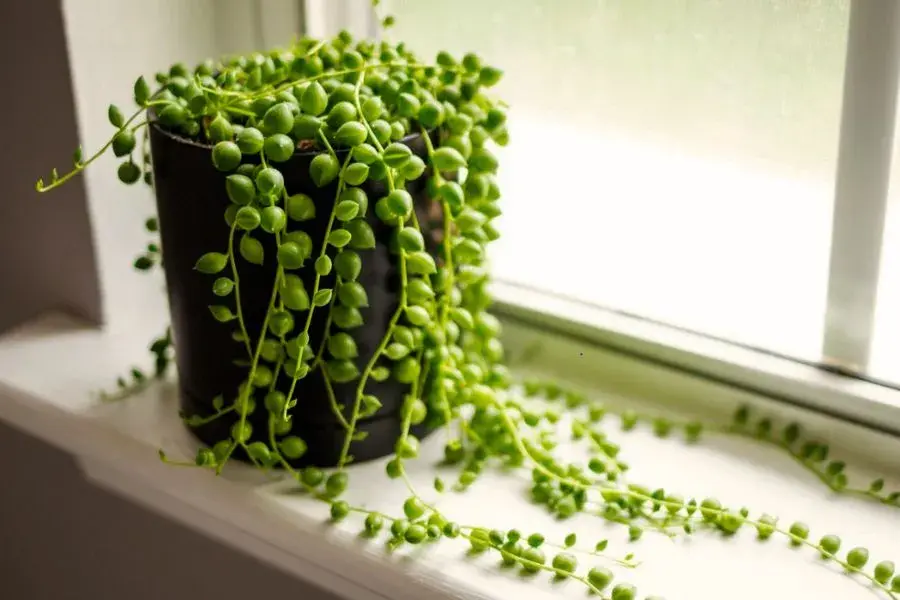
The string of Pearls, scientifically known as Curio rowleyanus, graces your hanging garden with cascading strings of bead-like foliage. These dainty pearls, resembling tiny green droplets, create an enchanting visual display. To nurture this succulent, place it in bright, indirect light, allowing it to bask in gentle sunshine without the intensity of direct rays. Use well-draining soil to prevent waterlogging, a common woe for succulents. Water sparingly, letting the soil dry out between watering sessions. Keep temperatures moderate, between 70-80°F (21-27°C), providing the ideal conditions for this delicate beauty to flourish.
2. String of Fishhooks (Senecio radicans)
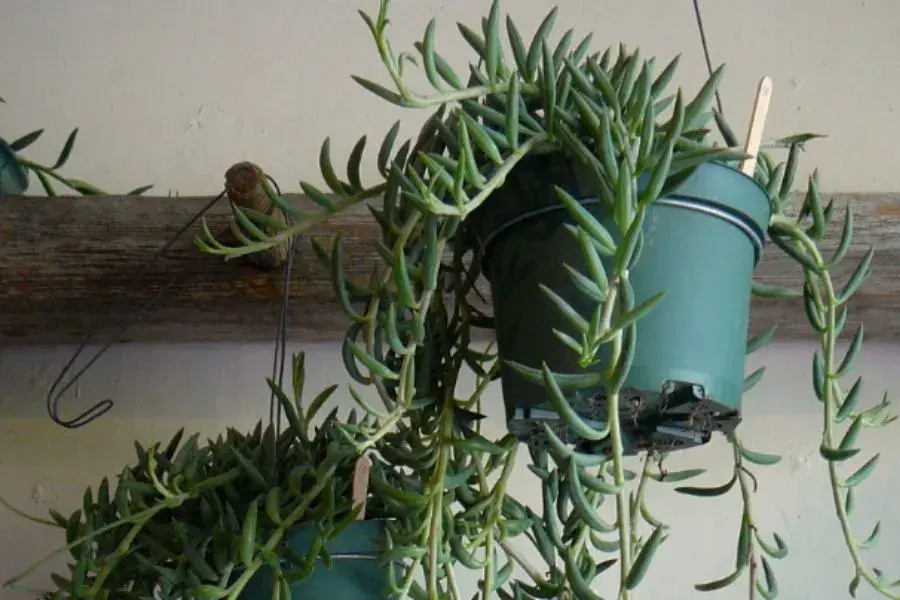
Embrace the exotic allure of String of Fishhooks, also known as Senecio radicans. With its long, trailing stems resembling a cascade of fishing hooks, this succulent adds a touch of the wild to your hanging garden. To ensure its thriving existence, place it in bright, indirect light, mimicking its natural habitat where it receives filtered sunlight. Use well-draining soil to prevent water accumulation around the roots. Water moderately, allowing the soil to dry slightly between watering. Prune occasionally to maintain its untamed charm and remove any dead or leggy growth.
3. String of Bananas (Curio radicans, formerly Senecio radicans)
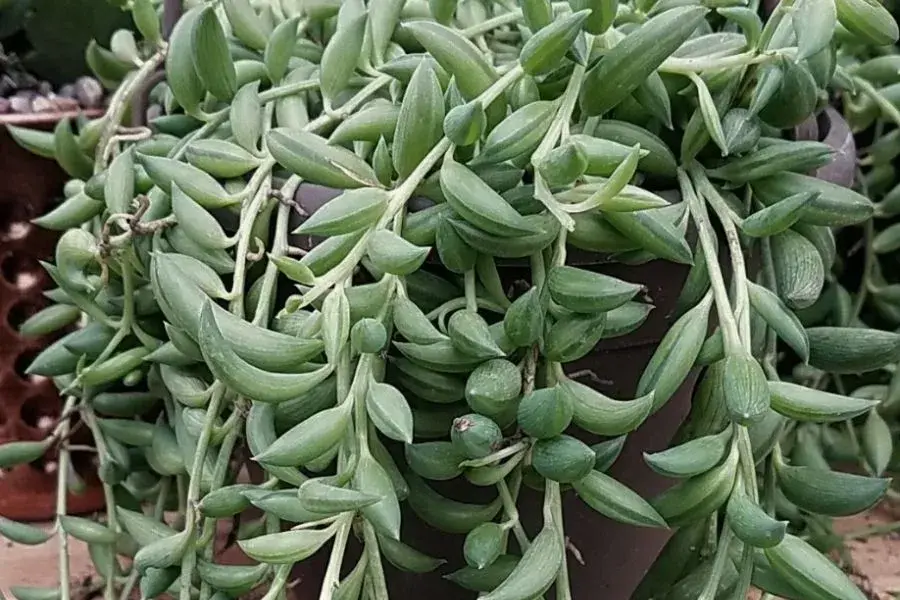
Formerly known as Senecio radicans, String of Bananas (Curio radicans) brings playful greenery in abundance. The trailing stems, adorned with banana-shaped leaves, create a whimsical and carefree atmosphere. Cultivate this joyful succulent by providing bright, indirect light, allowing it to drape gracefully. Use well-draining soil and water sparingly, letting the soil dry between watering sessions. String of Bananas thrives in temperatures above 50°F (10°C), so ensure a warm and cozy environment for continuous cascading beauty.
4. Burro’s Tail Sedum (Sedum morganianum)
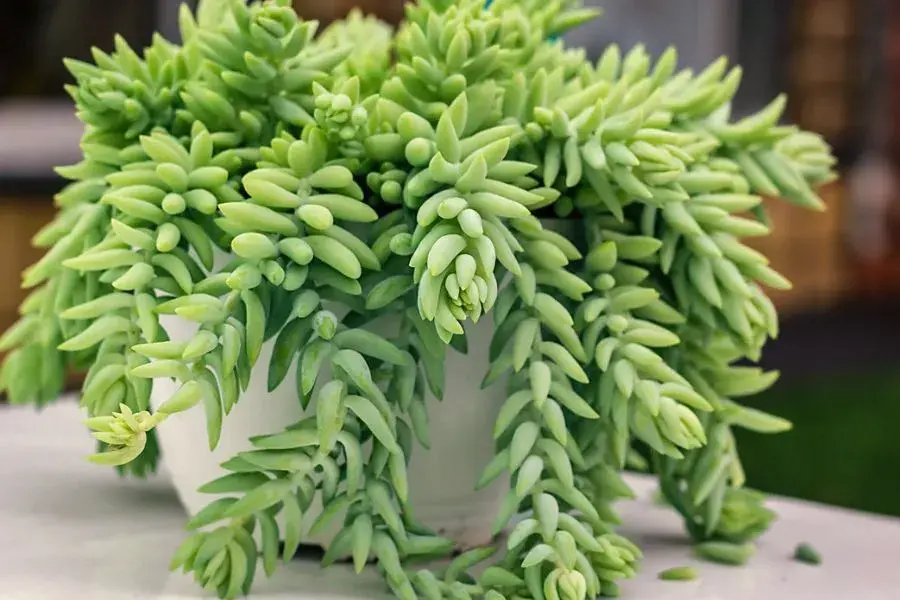
Witness the teardrops of verdant grace with Burro’s Tail Sedum, scientifically known as Sedum morganianum. This succulent’s trailing stems, adorned with plump, teardrop-shaped leaves, add a touch of whimsy and elegance to your hanging garden. To care for this charming succulent, provide bright, indirect light, ensuring it receives enough sunlight to maintain its vibrant green hue. Use well-draining soil, as these succulents are sensitive to overwatering. Water sparingly, allowing the soil to dry out completely between watering sessions. Protect them from cold drafts, maintaining a warm environment for optimal growth.
5. Elephant’s Food/Bush (Portulacaria afra)
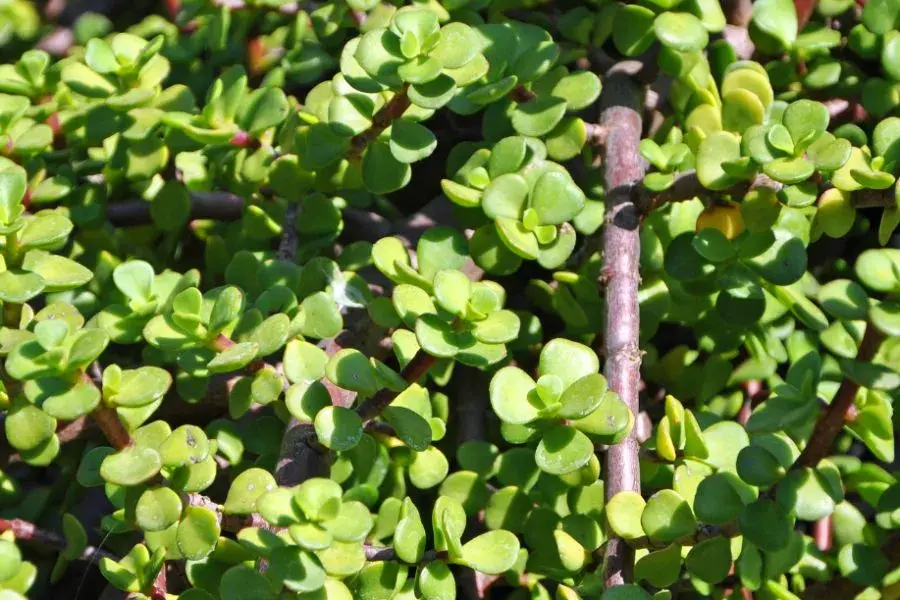
Create a hanging haven for Elephant’s Delight with Elephant’s Food/Bush, scientifically named Portulacaria afra. This succulent, with its small, round leaves, mimics the appearance of a miniature jade plant. To cultivate a lush cascade of greenery, place it in bright, indirect light, allowing it to thrive without being exposed to harsh sunlight. Use well-draining soil and water sparingly, allowing the soil to dry out between watering sessions. Elephant’s Food/Bush prefers a warm environment, so protect it from cold temperatures and frost.
6. Trailing/Hanging Jade (Peperomia rotundifolia)
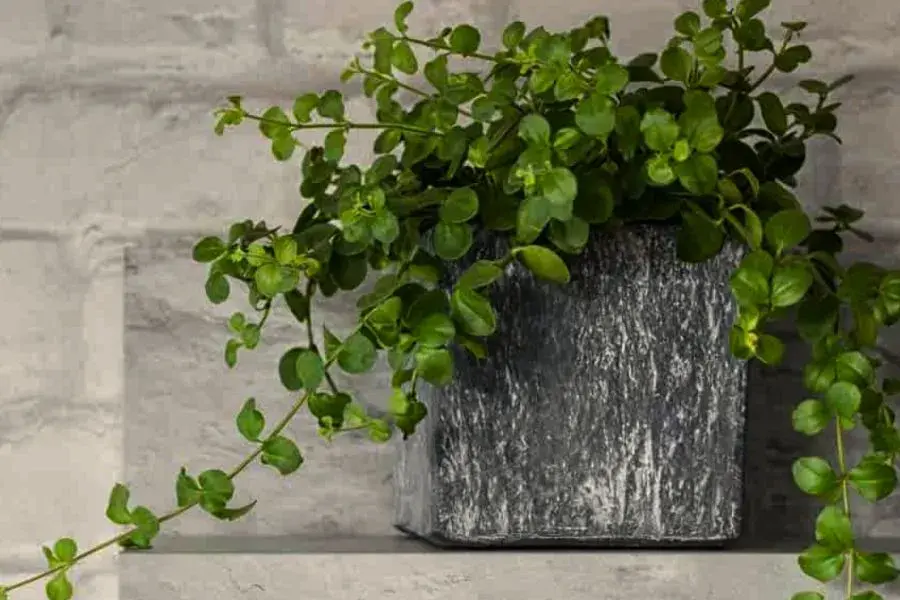
Experience the beauty of cascading jade elegance with Trailing/Hanging Jade, scientifically known as Peperomia rotundifolia. This succulent, with its glossy, round leaves, adds a touch of sophistication to your hanging garden. To ensure the timeless allure of this jade beauty, place it in bright, indirect light. Use a well-draining peat-based mix to provide the optimal growing medium. Water moderately, allowing the soil to remain slightly moist. Maintain a warm and humid environment, as these succulents thrive in such conditions, creating a lush and captivating cascade.
7. Ruby Necklace (Othonna capensis ‘Ruby Necklace’)
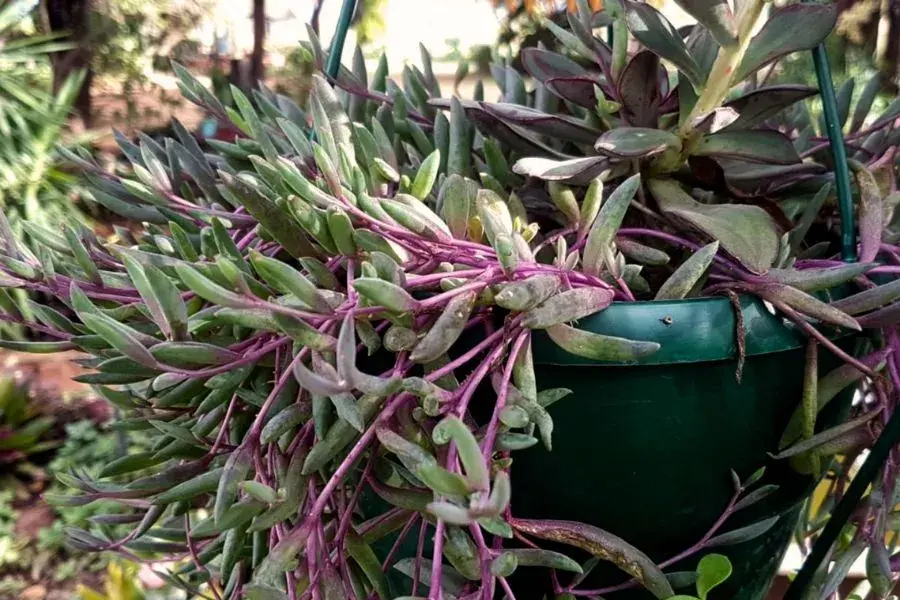
Adorn your hanging garden with trailing jewels of rich hues through Ruby Necklace, scientifically known as Othonna capensis ‘Ruby Necklace.’ The succulent’s slender stems, adorned with small, ruby-like leaves, create a visually stunning display. To cultivate this cascade of vibrant elegance, provide bright, indirect light, allowing it to receive the necessary sunlight for its rich coloration. Use well-draining soil and water sparingly, ensuring the soil dries out between watering sessions. Prune occasionally to maintain shape and remove any leggy growth, promoting a continuous display of jewel-toned cascades.
8. Air Plant (Tillandsia)
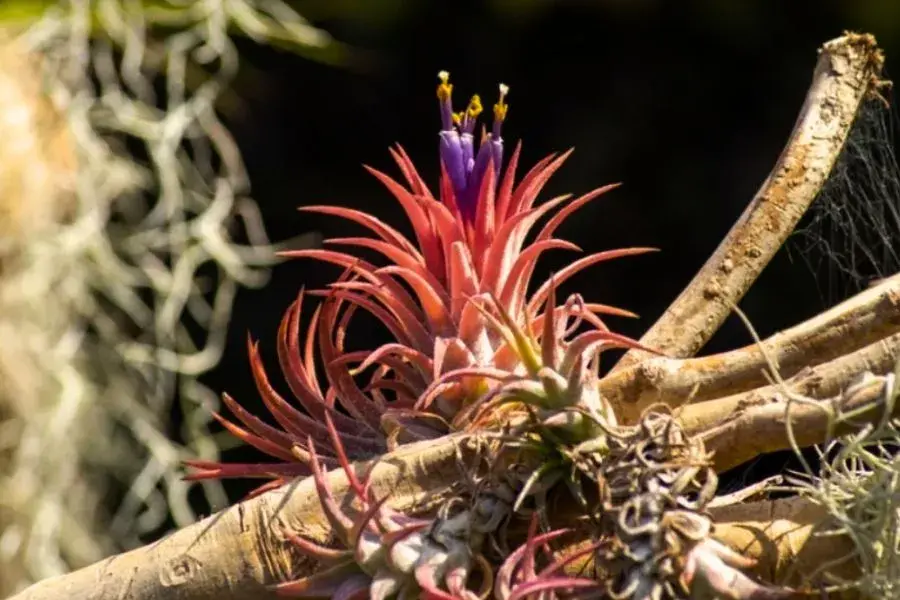
Step into the realm of ethereal beauty without boundaries with the Air Plant, scientifically known as Tillandsia. This unique succulent doesn’t require soil, making it a versatile addition to your hanging garden. To ensure the extraordinary beauty of the Air Plant, place it in bright, indirect light. Mist or soak the plant every 1-2 weeks, providing the necessary moisture. Ensure good air circulation around the plant, avoiding enclosed terrariums or containers. Air Plants are adaptable and can thrive in various conditions, making them a fascinating and low-maintenance addition to your hanging display.
9. Baby Necklace Crassula (Crassula Rupestris)
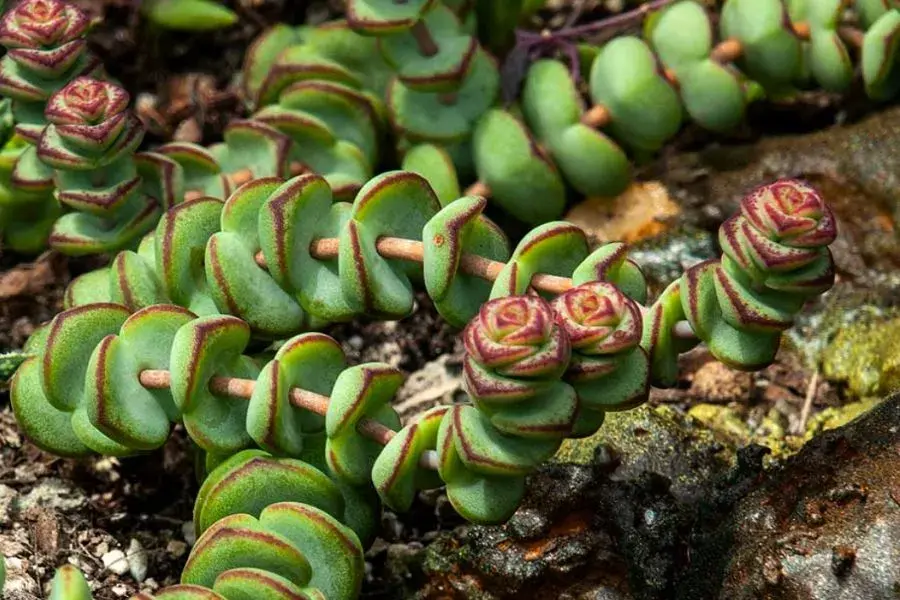
Discover tiny gems on cascading chains with Baby Necklace Crassula, scientifically named Crassula Rupestris. This succulent, with its compact, round leaves, forms delicate chains of greenery. To keep these tiny treasures flourishing, provide bright, indirect light. Use well-draining soil and water sparingly, allowing the soil to dry out between watering sessions. Baby Necklace Crassula is adaptable but prefers a warm environment for optimal growth. Ensure a well-ventilated space to avoid humidity-related issues, and watch as these tiny gems create a charming cascade in your hanging garden.
10. String of Hearts (Ceropegia woodii)
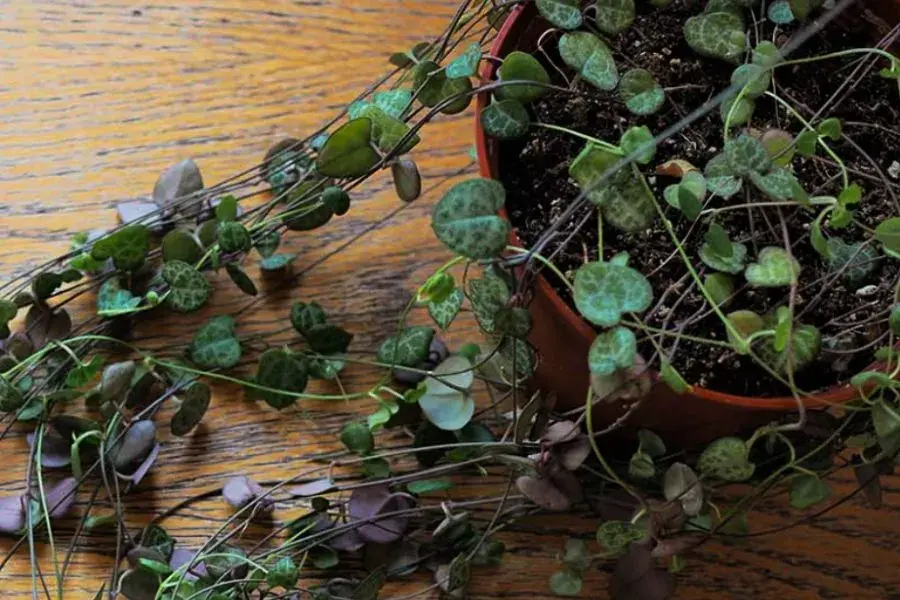
Embark on romantic trails of verdant affection with String of Hearts, scientifically known as Ceropegia woodii. This succulent, with its heart-shaped leaves, adds a touch of romance to your hanging garden. To ensure the delicate beauty of these trailing hearts, place them in bright, indirect light. Use well-draining soil and water moderately, allowing the soil to remain slightly moist. String of Hearts thrives in a warm and humid environment, so ensure adequate humidity for optimal growth. Explore the care tips that enhance the romantic allure of this succulent, creating a cascade of love in your space.
Read also: The Difference Between Shovels and Spades
General Care Tips for Hanging Succulents
Let’s lay down some foundational care tips. These guidelines will help ensure that your suspended botanical wonders thrive, providing you with long-lasting beauty and greenery. Whether you’re a seasoned plant enthusiast or just beginning your journey into the world of succulents, these general care tips serve as a compass for cultivating healthy and vibrant hanging succulents.
1. Light Requirements: Hanging succulents generally prefer bright, indirect light. While they can adapt to various light conditions, providing them with ample sunlight enhances their growth and vibrant colors. Shield them from harsh afternoon sun to prevent scorching, especially in warmer climates.
2. Soil Selection: Opt for a well-draining succulent mix. This prevents waterlogged soil, a common woe for succulents. Good drainage is crucial to prevent root rot, ensuring the overall health of your hanging succulents.
3. Watering Practices: Water sparingly and allow the soil to dry out between watering sessions. Overwatering is a common pitfall, as succulents are adapted to arid conditions. Adjust the frequency based on the specific needs of each succulent variety.
4. Temperature Considerations: Maintain a moderate temperature range between 70-80°F (21-27°C) for optimal growth. Protect hanging succulents from extreme temperatures, especially frost, which can be detrimental to their well-being.
5. Humidity Levels: Most hanging succulents thrive in average to low humidity levels. While they can adapt to various conditions, it’s essential to provide adequate ventilation to prevent humidity-related issues.
6. Pruning and Maintenance: Regular pruning helps maintain the shape and appearance of your hanging succulents. Remove any leggy or dead growth to encourage bushier and healthier plants. This practice also allows for better air circulation.
7. Container and Hanger Selection: Choose containers with drainage holes to prevent water accumulation. Select hangers or containers that complement the aesthetics of your hanging succulents while ensuring stability.
8. Monitoring and Adaptation: Observation is key to successful succulent care. Keep an eye on the changing needs of your plants, adjusting care practices based on seasonal variations and the specific requirements of each succulent variety.
FAQs about Hanging Succulents
1. Can hanging succulents be grown indoors?
Yes, hanging succulents can thrive indoors. They prefer bright, indirect light and are well-suited for hanging baskets or containers near windows. Ensure proper drainage to prevent overwatering.
2. How often should I water my hanging succulents?
Watering frequency varies by succulent type, but as a general rule, allow the soil to dry out between watering sessions. Overwatering can lead to root rot, so it’s crucial to adjust watering based on the specific needs of each succulent.
3. What’s the best soil for hanging succulents?
Opt for a well-draining succulent mix or make your own by adding perlite or sand to regular potting soil. Good drainage is essential to prevent waterlogging and ensure the health of your hanging succulents.
4. Can hanging succulents survive in low-light conditions?
While hanging succulents prefer bright, indirect light, many can adapt to lower light conditions. However, they may become leggy or lose some vibrancy. Rotate them occasionally to ensure even light exposure.
5. How do I prevent pests in my hanging succulents?
Inspect your succulents regularly for signs of pests like aphids or spider mites. Isolate affected plants if necessary, and treat pests with insecticidal soap or neem oil. Maintaining good air circulation helps deter pests.
Final Words
In the grand finale of our hanging succulent journey, we find ourselves immersed in a symphony of verdant elegance. From the dainty droplets of String of Pearls to the romantic trails of String of Hearts, each succulent tells a story of resilience and natural sophistication. As we bid adieu to this hanging tapestry, let it be a reminder that cultivating these suspended wonders is not just a horticultural endeavor—it’s a dance with living sculptures. May your hanging garden be a testament to the beauty of mindful care, bringing timeless elegance and nature’s grace to new heights. Happy succulent gardening!